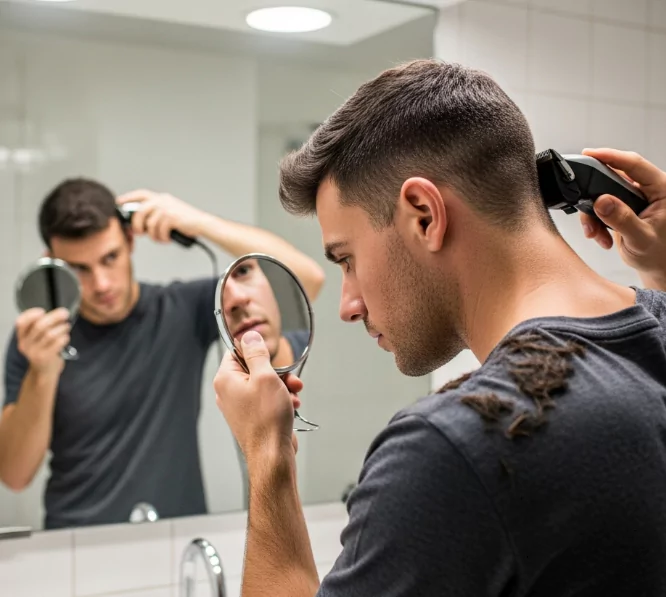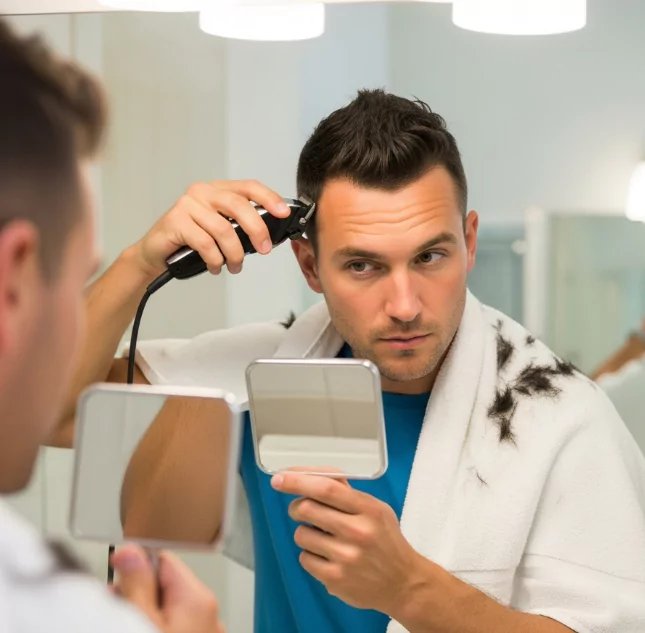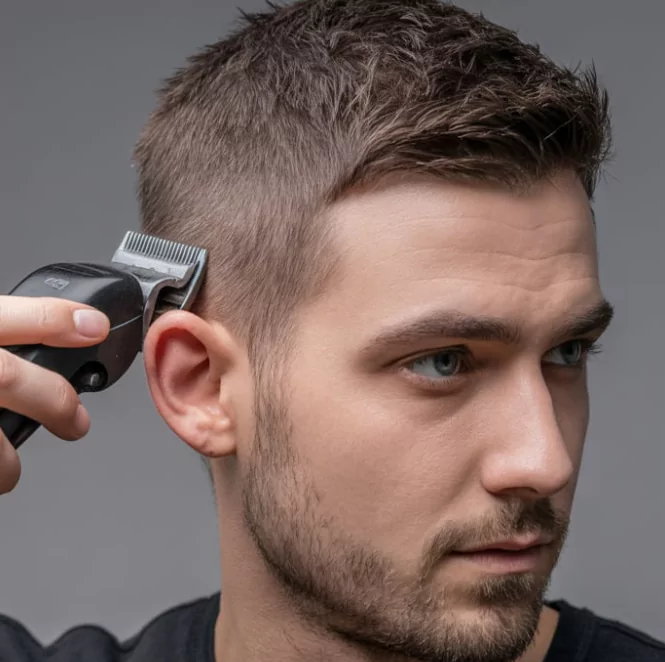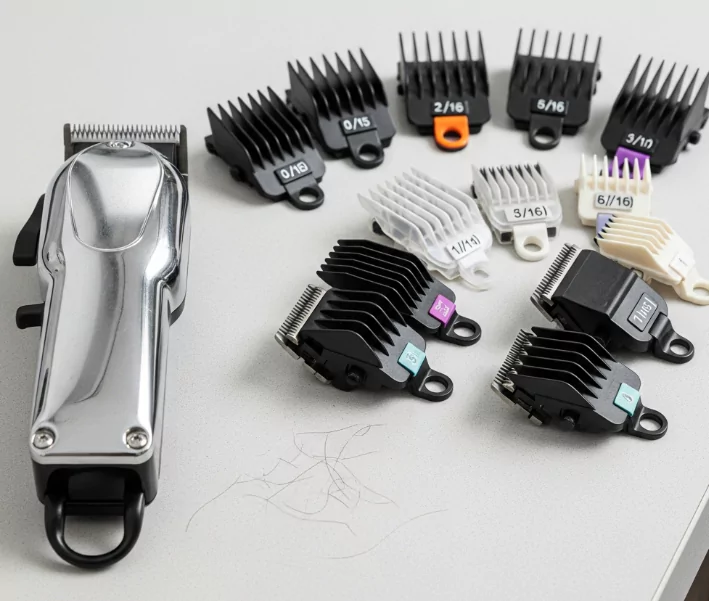Learning how to cut your own hair with male clippers can save you hundreds of dollars annually while giving you complete control over your style. As a professional barber with 15 years of experience, I’ve perfected these haircut techniques that anyone can master at home.
How to Cut Men’s Hair with Male Hair Clippers
Male clippers have revolutionized home grooming, making salon-quality cuts accessible to everyone. The key lies in understanding proper haircut tutorial technique and following systematic steps that prevent common mistakes.
“The difference between a great haircut and a disaster is patience and preparation,” says master barber Tony Rodriguez from New York’s Premier Barbershop.
Step by Step Instructions on How to Cut Your Own Hair with Clippers

Step 1: Prepare Your Hair Properly
Start your DIY haircut with clean, completely dry hair. Wash and condition your hair 24 hours before cutting—freshly washed hair can be too soft for precise control. Dry hair shows its natural texture and hair growth direction, essential for even cutting.
Hair maintenance begins with proper preparation. Detangle completely using a wide-tooth comb, especially if you have thick or curly hair. This hair care before cutting step prevents snagging and uneven patches.
Step 2: Set Up Your Cutting Environment
Establish your home haircut guide workspace near natural light with multiple mirrors for haircut visibility. Your bathroom works perfectly, but ensure you have a handheld mirror for back-of-head angles.
Place a cape or old towel around your shoulders. Good lighting prevents missed spots that create uneven results in your barber tips at home routine. Position yourself in a comfortable place where you won’t be rushed.
Step 3: Begin With Basic Clipper Technique
Start cutting with a longer clipper guard than your target length—you can always go shorter. For beginners, use a #4 guard (12mm) even if you want a #3 finish using proper hair clipper settings.
Trim hair at home using steady, overlapping strokes. Each pass should overlap the previous by 25-50% to prevent missed sections. Work systematically from one side to the other following grooming tools best practices.
Step 4: Master the Back Section Technique
Trim the back of your hair requires careful mirror for haircut work and patience. Hair sectioning helps maintain consistent hair length and prevents uneven patches. Use your non-dominant hand to feel for evenness while the dominant hand controls the male clippers.
Move the male clippers against natural hair growth direction for the closest cut. Maintain precise pressure—forcing creates choppy, uneven results in your male haircut.
Step 5: Create Professional Fade Effects

Give yourself a fade using proper fade haircut technique that requires at least three different guard lengths and strategic comb attachments. Start with your longest guard at the top, transition to medium length at mid-head, then shortest at the bottom.
The key to professional taper haircut results is the flick-out motion. As you reach transition points, slightly lift hair and angle the clippers away from your head. This creates the gradual blend that separates amateur from professional haircut measurements.
Step 6: Add Precision With Detail Tools
Use scissors or a comb to help refine areas where clippers struggle. Hair scissors become essential for detail work around ears and edge trimming zones. Use the comb to lift hair sections and check for evenness.
Grooming tools work together—clippers for bulk removal, scissors for precision, and combs for guidance during hair styling preparation.
Step 7: Perfect Your Overall Shape
Refine your hair by stepping back frequently to assess progress using systematic haircut steps methodology. Use both mirrors to check all angles. Any visible lines need additional blending with intermediate clipper guard sizes.
Hair styling product reveals imperfections, so apply a small amount to see the final texture and catch any missed areas requiring hair trimming tips.
Step 8: Shape Your Sideburns Symmetrically
Cut your sideburns requires careful attention and hairline shaping skills. Use your non-dominant hand to feel both sides simultaneously, ensuring equal length and angle.
Trim hair conservatively around the ears—you can always remove more, but regrowing takes weeks according to standard hair growth patterns.
Step 9: Complete Your Finishing Touches
Make final touches on your haircut by cleaning up the neckline using the natural curve connecting your earlobes as a guide. Never cut above this hairline management zone—it looks artificial and grows out awkwardly.
Remove any stray hairs and blend remaining harsh lines using proper hair designing techniques for a clean finish.
Step 10: Clean Up and Style Your Results
Rinse thoroughly to remove loose hairs clinging to your scalp and neck. This reveals the true cut and any areas needing touch-ups. Apply minimal styling products to achieve your desired finish and photograph your work from multiple angles for complete assessment.
Tips for Cutting Your Own Hair

“Start conservative and work gradually shorter—hair grows back, but patience prevents disasters,” advises celebrity stylist Maria Chen specializing in haircut safety.
Always cut in good lighting conditions. Work systematically rather than randomly jumping between sections. Take frequent breaks to assess progress objectively. Most importantly, practice makes perfect when mastering home haircut techniques and building confidence.
Hair Length Numbers 101

Hair length numbers follow this standardized system: #1 guard cuts to 3mm, #2 to 6mm, #3 to 10mm, continuing up to #8 at 25mm. Clipper guards in half-sizes (#1.5, #2.5) create smoother transitions for complex fade haircuts.
Professional tip: fine hair appears short after settling naturally, while thick coarse hair springs back up, requiring adjusted haircut measurements and technique modifications.
What You Need to Cut Your Own Hair with Clippers
Essential hair clippers ($50-150 price range), complete guard set, quality handheld mirror, fine-tooth comb, sharp hair scissors for detail work, neck brush for cleanup, and protective cape.
Male clippers featuring self-sharpening blade technology provide consistently clean results. Mid-range models offer optimal value for home haircut guide enthusiasts seeking professional hair maintenance outcomes.
Mastering these proven haircut techniques and essential hair trimming tips transforms your home grooming routine completely, saving substantial money while ensuring clean, professional-looking results every time you cut hair at home.
FAQS
How to use a hair clipper for beginners?
Learn how to cut hair using clippers as a beginner with step-by-step guidance to get a clean, even haircut at home.
Should clippers be used on wet or dry hair?
For best results when learning how to cut your own hair male clippers, always use clippers on dry hair to ensure precision and even trimming.
Do you cut hair up or down with clippers?
When learning how to use a beard trimmer or hair clippers, cut hair in the direction it grows, moving clippers down for a natural finish.
What does 1, 2, 3, 4, 5 mean in haircuts?
The numbers 1–5 on clippers indicate hair length, helping you cut your own hair male clippers precisely from shortest (1) to longer (5).




